ISSN ONLINE(2320-9801) PRINT (2320-9798)
ISSN ONLINE(2320-9801) PRINT (2320-9798)
D.Yasar Arfath1, K.R.Kavitha2
|
| Related article at Pubmed, Scholar Google |
Visit for more related articles at International Journal of Innovative Research in Computer and Communication Engineering
In this paper we investigate the tour planning for mobile data gathering in wireless sensor node by introducing mobility into the network. An M-collector starts the data-gathering tour periodically from the static data sink, polls each sensor and then directly collects data from the sensor in single-hop communications, and transports it into the static sink. Our mobile data-gathering scheme improves the scalability and solves intrinsic problems. By introducing the M-collector, data gathering becomes more flexible and adaptable to the unexpected changes of the network topology. M-collector will separate each zone that will reduce the network faults. In addition, data gathering by Mcollectors is perfectly suitable for applications, where sensors are only partially connected. proposed data-gathering scheme can greatly reduce the moving length compared with the covering line algorithm. In addition, it can prolong the network lifetime significantly compared with the scheme that has only a static data collector.
I. INTRODUCTION |
| WIRELESS Sensor Network (WSN) consist of hundreds or thousands of sensor nodes and a small number of data collection devices [1]. The sensor nodes have the form of lowcost, low-power, small-size devices, and are designed to carry out a range of sensing applications, including environmental monitoring, military surveillance, fire detection, animal tracking, and so on. The sensor nodes gather the information of interest locally and then forward the sensed information over a wireless medium to a remote data collection device (sink), where it is fused and analyzed in order to determine the global status of the sensed area. In many WSN applications, the sensor nodes are required to know their locations with a high degree of precision, such as tracking of goods, forest fire detection, and etc. |
II. PROPOSED SYSTEM: |
| Focus on the problem of minimizing the length of each data-gathering tour and refer to this as the single-hop datagathering problem (SHDGP).Formalize the SHDGP into a mixed-integer program and then present a heuristic tourplanning algorithm for the case where a single M-collector is employed. The proposed data-gathering algorithm can greatly shorten the moving distance of the collectors compared with the covering line approximation algorithm and is close to the optimal algorithm for small networks. Thus data-gathering scheme can significantly prolong the network lifetime compared with a network with static data sink We also consider utilizing multiple M-collectors and propose a data-gathering algorithm where multiple M-collectors traverse through several shorter sub tours concurrently to satisfy the distance/time constraints. The effectiveness of our proposed algorithms is verified by comparing with another data-gathering algorithm. |
| 2.1MODULES DESCRIPTION |
| Module1: network creation and routing |
| In this module, a sample network is to be created. A network with ‘n’ number of nodes is to be created. All the nodes are deployed randomly across the network. All the nodes can communicate each other. The wireless properties are given to the network. Since our network is Sensor Network, a DATA SINK should be created. To configure the data sink a patch file “sensorsim-2.27” is to be added The normal sensor nodes are to be configured in the network. A protocol called AODV is to be implemented to route the packets across the network. UDP, NULL agents are used to configure the sender and receiver nodes. CBR (constant bit rate) is provided with the sender and receiver that provide the packet flow between the nodes. |
| Module 2: Implementation of data gathering node |
| In this module, each and every node is made to contact with the data sink. The nodes are the network transmits the sensed data to the data sink directly. Energy consumption on sensing is relatively stable because it only depends on the sampling rate and does not depend on the network topology or the location of sensors. applications of sensor networks may be quite diverse, most of them share a common feature. Their data packets may need to be aggregated at some data sink. In a homogeneous network where sensors are organized into a flat topology, sensors close to the data collector consume much more energy than sensors at the margin of the network, since they need to relay many packets from sensors far away from the data collector. |
| Module 3: Performance analysis |
| In this module, the efficiency of the nodes to transmit the data and the efficiency of the data sink to collect the data is analyzed. after these sensors fail, other sensors cannot reach the data collector and the network becomes disconnected, although most of the nodes can still survive for a long period. sensors are densely deployed and connected, whereas sensors that belong to different areas may be disconnected. Unlike fully connected networks, some sensors cannot forward data to the data sink via wireless links. |
| Module 4: Implementation of m-collector node |
| In this module we provide a scalable data-gathering scheme for large-scale static sensor networks, we utilize mobile data collectors to gather data from sensors. Specifically, a mobile data collector could be a mobile robot or a vehicle equipped with a powerful transceiver, battery, and large memory. The mobile data collector starts a tour from the data sink, traverses the network, collects sensing data from nearby Polling point nodes while moving, and then returns and uploads data to the data sink. Since the data collector is mobile, it can move close to sensor nodes, such that if the moving path is well planned, the network lifetime can be greatly prolonged. |
| Module 5: Result analysis |
| In this module we demonstrate that our proposed data-gathering scheme can greatly reduce the moving length compared with the covering line algorithm and is close to the optimal algorithm in small networks. In addition, it can prolong the network lifetime significantly compared with the scheme that has only a static data collector and the scheme in which the mobile data collector can only move along straight lines |
III. IMPLEMENTATION AND RESULTS |
| Different cluster region with cluster head and mobile anchor node: |
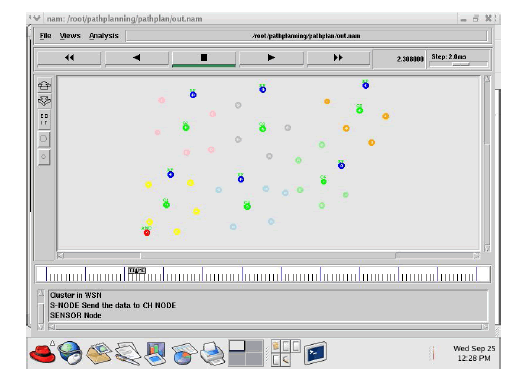 |
| The above fig shows Different cluster regions with cluster head and mobile anchor node which are used to assist the sensor nodes in order to determine the sensing field. The mobile anchor nodes moves randomly through the sensing field. |
| Beacon point transmission: |
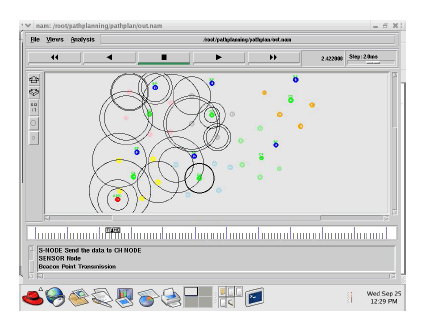 |
| As the anchor node moves through the sensing field, it broadcasts its coordinates periodically and each sensor node chooses appropriate locations of the anchor node called beacon points. In the localization scheme, a single anchor node moves randomly through the sensing field broadcasting beacon messages containing its current coordinates |
| Beacon transmission along mobile anchor: |
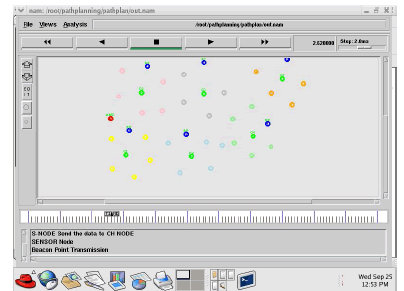 |
| It shows the beacon messages are transmitted along the mobile anchor nodes. |
| Data collection from localization: |
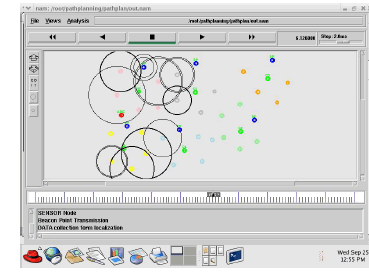 |
| Finally the Sensor node gathers the information that is collected the data from the localization. |
| Energy graph |
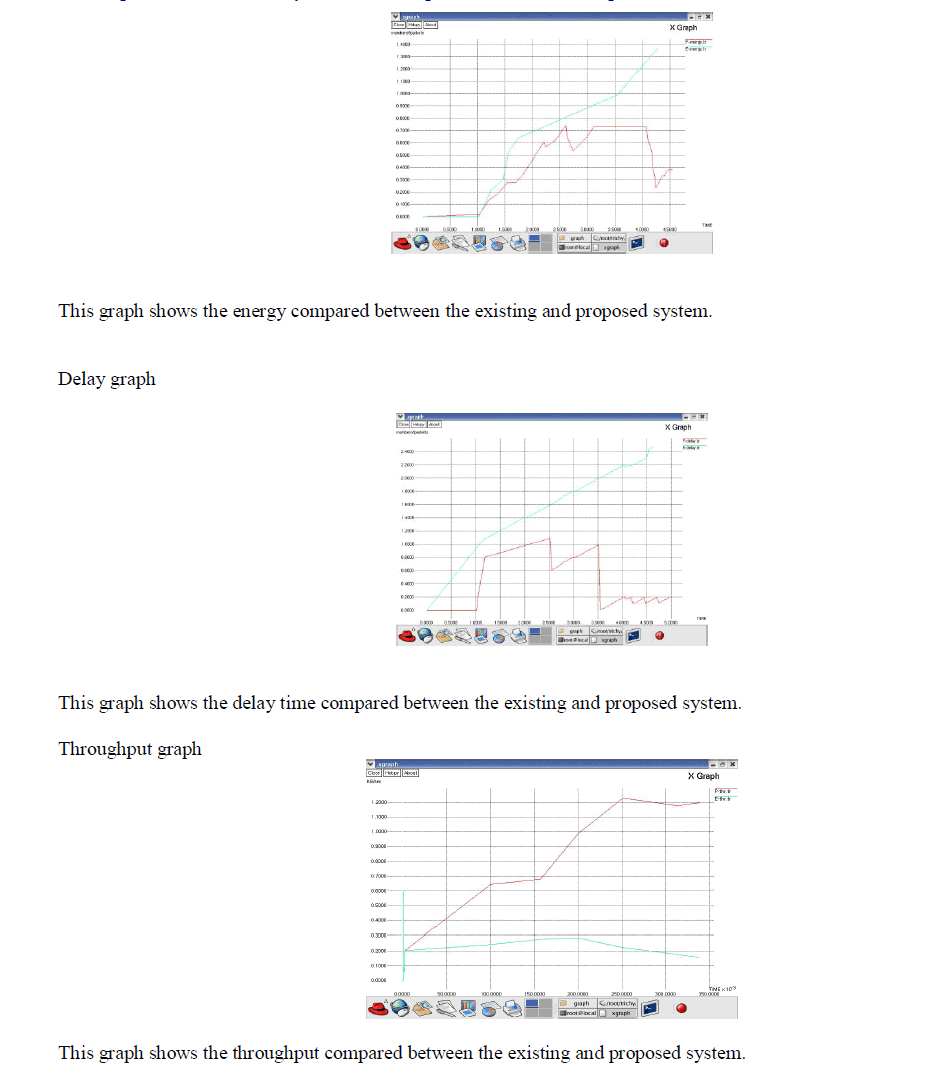 |
IV. CONCLUSION |
| Mobile data-gathering scheme improve the scalability and solves intrinsic problems. By using the Mcollector, data gathering becomes more flexible and adaptable to the unexpected changes of the network topology. Mcollector will separate each zone that will reduce the network faults. In addition, data gathering by M-collectors is perfectly suitable for applications, where sensors are only partially connected. Proposed data-gathering scheme can greatly reduce the moving length compared with the covering line algorithm. |
References |
|